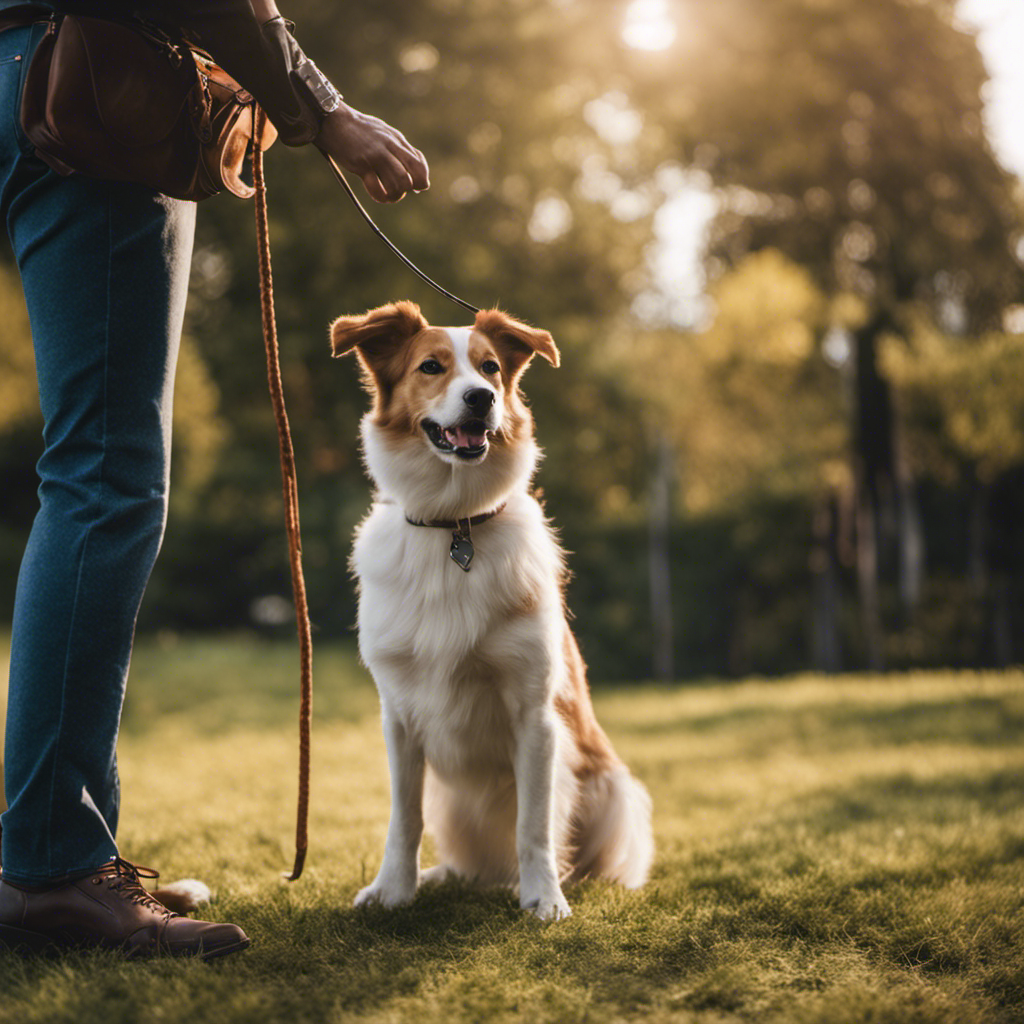- Key Takeaways
- The Importance of In Piedi in Italian Dog Training
- Step-by-Step Guide to Teaching In Piedi to Your Dog
- In Piedi: A Versatile Command for Everyday Situations
- Mastering In Piedi: Tips and Tricks for Success
- Common Challenges and Solutions When Teaching in Piedi
- Taking In Piedi to the Next Level: Advanced Techniques
- Incorporating in Piedi Into Obedience Training Routines
- Fun and Creative Ways to Practice in Piedi With Your Dog
Click and GO TO THE BEST DOG NAME GENERATOR HERE

Want to take your dog training to the next level? Look no further than the versatile command of ‘In Piedi’ in Italian. This command, which translates to ‘stand up,’ is a must-have in your repertoire.
In Piedi can be used in a variety of everyday situations, making it an essential skill for any well-trained dog. In this article, we’ll guide you step-by-step on how to teach In Piedi to your furry friend, and share some expert tips and tricks for success.
Get ready to elevate your training game!
- Key Takeaways
- The Importance of In Piedi in Italian Dog Training
- Step-by-Step Guide to Teaching In Piedi to Your Dog
- In Piedi: A Versatile Command for Everyday Situations
- Mastering In Piedi: Tips and Tricks for Success
- Common Challenges and Solutions When Teaching in Piedi
- Taking In Piedi to the Next Level: Advanced Techniques
- Incorporating in Piedi Into Obedience Training Routines
- Fun and Creative Ways to Practice in Piedi With Your Dog
Key Takeaways
- ‘In Piedi’ is an important command in Italian dog training to teach dogs to stand up.
- The command helps establish the trainer as the pack leader and encourages prompt response.
- Positive reinforcement techniques, such as using treats and praise, are effective in teaching ‘In Piedi’.
- ‘In Piedi’ can be used in various situations, including leash training, managing dog interactions, and preventing unwanted behaviors.
The Importance of In Piedi in Italian Dog Training
You should utilize the command ‘In Piedi’ to teach your dog to stand up during Italian dog training. Teaching your puppy to stand up on command is an essential part of their obedience training. By using the ‘In Piedi’ command, you can establish yourself as the pack leader and teach your dog to respond to your instructions promptly.
When teaching ‘In Piedi’ to puppies, it’s important to start with short training sessions and use positive reinforcement techniques. Begin by holding a treat in front of your puppy’s nose and slowly raise it upwards while giving the command ‘In Piedi.’ As your puppy stands up to reach for the treat, reward them with praise and the treat. Repeat this exercise several times until your puppy understands the command and can stand up consistently.
In addition to teaching your dog to stand up, ‘In Piedi’ can also be used for leash training. When your dog is pulling on the leash during walks, you can give the command ‘In Piedi’ to encourage them to stand still. This allows you to regain control and redirect their attention back to you.
Remember to be patient and consistent when training your dog with the ‘In Piedi’ command. With time and practice, your furry friend will become skilled at standing up on command and following your lead.
Step-by-Step Guide to Teaching In Piedi to Your Dog
Follow this step-by-step guide to easily teach your dog the command ‘In Piedi’ and help them master the skill of standing up on command.
-
Start with a solid foundation: Before teaching ‘In Piedi,’ make sure your dog has mastered basic commands like ‘Sit’ and ‘Stay.’ This will ensure they’ve a good understanding of obedience and will make the learning process smoother.
-
Introduce the command: Use a clear, authoritative voice and the hand signal for ‘Stand Up’ while saying ‘In Piedi.’ Repeat this command consistently, making sure to reward your dog each time they follow it correctly.
-
Practice in different environments: Dogs can be stubborn, so it’s important to practice ‘In Piedi’ in various locations and distractions. This will help your dog generalize the command and respond reliably in any situation.
-
Incorporate ‘In Piedi’ into agility training: Once your dog has mastered standing up on command, you can integrate it into their agility training. Use the command to have them stand on specific obstacles or as a transition between different agility exercises.
Teaching ‘In Piedi’ to stubborn dogs may require patience and consistency, but with this step-by-step guide, you can successfully teach your dog this useful command and incorporate it into their agility training.
Happy training!
In Piedi: A Versatile Command for Everyday Situations
Although it may seem simple, incorporating the command ‘In Piedi’ into your dog’s training can greatly enhance their ability to respond in everyday situations. This versatile command can be used to manage your dog’s behavior outside of training and can be particularly useful when interacting with other animals. By teaching your dog to ‘In Piedi’, you are giving them a clear cue to stand up on all four legs.
Using ‘In Piedi’ to manage dog interactions with other animals can be very beneficial. For example, if your dog tends to get overly excited or aggressive when approaching other dogs, using the ‘In Piedi’ command can help you regain control of the situation. By instructing your dog to stand up, you are redirecting their focus and preventing them from engaging in unwanted behaviors.
Here is a table showcasing the benefits of incorporating ‘In Piedi’ into your dog’s training and how it can be used to manage dog interactions with other animals:
| Benefits of ‘In Piedi’ | How to Use ‘In Piedi’ to Manage Dog Interactions with Other Animals |
|---|---|
| Enhances response in everyday situations | Use ‘In Piedi’ to redirect your dog’s focus when approaching other animals |
| Increases control over your dog’s behavior | Teach your dog to stand up as a way to prevent unwanted behaviors |
| Improves communication between you and your dog | Reinforce the ‘In Piedi’ command consistently and reward your dog for complying |
Mastering In Piedi: Tips and Tricks for Success
To master the command ‘In Piedi’ and ensure success, there are a few key tips and tricks you should keep in mind.
Firstly, it’s important to use effective training techniques such as positive reinforcement and consistency.
Secondly, be aware of common mistakes to avoid, like using harsh or confusing commands, or failing to reward your dog for their correct response.
Effective Training Techniques
You can enhance your dog’s training by incorporating effective techniques like using positive reinforcement and breaking down the command into smaller steps. Here are four techniques that can help you achieve better results:
-
Use crate training: Introduce your dog to a crate as a safe and comfortable space. This won’t only prevent accidents but also provide a sense of security for your dog during the training process.
-
Utilize positive reinforcement techniques: Reward your dog with treats, praise, or playtime when they successfully perform the desired behavior. This will motivate them to repeat the behavior in the future.
-
Break down the command into smaller steps: Teach your dog the command gradually, starting with easier tasks and gradually increasing the difficulty. This will make it easier for your dog to understand and follow the command.
-
Be consistent and patient: Consistency is key in dog training. Set a routine and stick to it. Additionally, be patient with your dog as they learn and progress at their own pace.
Common Mistakes to Avoid
Don’t underestimate the importance of practicing the ‘In Piedi’ command both at home and in public to ensure success with your dog.
When training your dog to ‘In Piedi’, there are common mistakes that you should avoid. One common mistake isn’t being consistent with the command. Make sure to use the same verbal cue and hand signal every time you ask your dog to stand up.
Another mistake isn’t rewarding your dog immediately after they successfully perform the command. Timing is crucial in training, so be sure to praise and reward your dog promptly to reinforce the behavior.
Additionally, it’s important to avoid using force or punishment when teaching ‘In Piedi’. Instead, use positive reinforcement techniques such as treats or praise to motivate your dog.
By following these tips, you can successfully train your dog to ‘In Piedi’ and strengthen your bond.
Now, let’s explore common challenges and solutions when teaching ‘In Piedi’.
Common Challenges and Solutions When Teaching in Piedi
Get up and face the common challenges when teaching in Piedi by finding effective solutions. Teaching in Piedi, or standing up, can present its own set of challenges, but with the right approach, you can overcome them and create a successful learning environment.
Here are some common mistakes when teaching in Piedi and how to troubleshoot them:
-
Lack of engagement: Students may lose interest or become distracted when standing for extended periods. To troubleshoot this, incorporate interactive activities such as group discussions or hands-on projects to keep their attention and make the lesson more engaging.
-
Physical discomfort: Standing for long periods can be tiring and uncomfortable for both teachers and students. To address this, ensure that the classroom is properly equipped with standing desks or adjustable height tables. Encourage students to take short breaks and stretch to alleviate any physical discomfort.
-
Limited movement: Standing in one place can restrict movement and hinder student participation. To overcome this, encourage students to move around the classroom during discussions or group work. Incorporate physical activities or games that involve movement to keep them active and energized.
-
Ineffective use of space: A poorly organized classroom can make it difficult for students to navigate and participate. Troubleshoot this by arranging the classroom in a way that allows for easy movement and interaction. Use clear signage or visual cues to guide students and make the most of the available space.
Teaching in Piedi may have its challenges, but by implementing these solutions, you can create a dynamic and engaging learning experience for your students.
Taking In Piedi to the Next Level: Advanced Techniques
To truly elevate your teaching in Piedi, try incorporating advanced techniques such as using props and incorporating technology. These methods can enhance your training sessions and help your students improve their balance and coordination. Advanced balancing techniques, in particular, can take your in Piedi training to the next level.
One way to incorporate advanced balancing techniques is by using props. Props such as balance boards, wobble cushions, or BOSU balls can challenge your students’ stability and core strength while in the standing position. By introducing these props into your training sessions, you can provide a dynamic and engaging experience for your students.
In addition to props, incorporating technology can also enhance your in Piedi training. There are various apps and online platforms available that provide interactive exercises and visual aids to support your teaching. These tools can help your students visualize correct posture and alignment while standing and provide real-time feedback on their performance.
By combining advanced balancing techniques with the use of props and technology, you can create a comprehensive and effective in Piedi training program. Below is a table showcasing some examples of advanced balancing techniques and the props that can be used to support them:
| Balancing Technique | Prop |
|---|---|
| Single-leg stance | Balance board |
| Tandem stance | Wobble cushion |
| Eyes closed | BOSU ball |
| Dynamic movements | Resistance bands |
Incorporating these techniques and props into your teaching can help your students develop better balance, stability, and overall strength in the Piedi position. So why not take your in Piedi training to the next level and watch your students thrive?
Incorporating in Piedi Into Obedience Training Routines
You can easily incorporate in Piedi into your obedience training routines by using a combination of verbal commands and hand signals. In Piedi, which means ‘Stand Up’ in Italian, is a valuable command that can bring numerous benefits to your dog’s training.
Here’s how you can effectively integrate in Piedi into your obedience training:
-
Start with the basics: Teach your dog the verbal command ‘in Piedi’ while simultaneously using a hand signal, such as lifting your hand palm-up in front of your dog’s nose.
-
Reinforce the command: Once your dog understands the command, practice it regularly during obedience training sessions. Consistency is key to solidifying the behavior.
-
Use in Piedi as a tool for impulse control: Incorporate in Piedi into situations where your dog tends to become overly excited or impulsive. By asking your dog to stand up and remain calm, you’re teaching them self-control and patience.
-
Apply in Piedi in agility training: In Piedi can also be useful in agility training. Teaching your dog to stand up and wait for your command can help improve their focus and precision during agility exercises.
Fun and Creative Ways to Practice in Piedi With Your Dog
Looking for fun and creative ways to practice in Piedi with your dog?
Engaging training games can be a great way to reinforce this command while keeping things interesting for both you and your pup.
You can also incorporate everyday household objects, like chairs or stools, to practice in Piedi in different environments.
For a change of scenery, take your dog outside and find outdoor practice scenarios that allow you to work on in Piedi while enjoying the fresh air.
Engaging Training Games
Try playing the ‘Paw Freeze’ game to practice in Piedi with your dog. This engaging training game is a fun way to incorporate in piedi into your obedience training routines.
Here’s how to play:
- Start by commanding your dog to ‘In Piedi’ or ‘Stand Up.’
- Once your dog is in the standing position, give the command ‘Paw Freeze.’
- Hold out a treat in your hand and encourage your dog to lift one paw and freeze in that position.
- Reward your dog with the treat and praise when they successfully hold their paw up.
Playing this game not only helps reinforce the in piedi command but also encourages balance and focus. It’s a great way to make training sessions enjoyable for both you and your furry friend.
Now, let’s move on to another exciting topic: incorporating everyday household objects into your dog’s training routine.
Everyday Household Objects
Let’s get creative and discover new ways to practice in piedi with your dog using everyday household objects like chairs and tables. Teaching your dog to stand up on command, also known as “in piedi” in Italian, is not only a useful obedience skill but can also be incorporated into agility training. Different dog breeds may have different physical abilities and temperaments, so it’s important to adapt your training methods accordingly. To practice in piedi, you can use a chair as an elevated platform for your dog to stand on. Start by luring your dog onto the chair with a treat, then give the command “in piedi” and reward them for standing up. Another option is to use a table as a makeshift obstacle in an agility course, including an “in piedi” command to have your dog stand on the table for a few seconds before continuing with the course. By utilizing everyday household objects, you can make training sessions more engaging and enjoyable for both you and your furry friend.
| Object | Exercise | Benefits |
|---|---|---|
| Chair | Lure your dog onto the chair and command “in piedi” | Teaches your dog to stand up on command |
| Table | Incorporate an “in piedi” command in agility training | Strengthens agility skills and focus |
| Household object | Use any stable object as a platform for “in piedi” | Provides variety in training routines |
Outdoor Practice Scenarios
Have you tried incorporating outdoor objects, like tree stumps or picnic tables, into your in piedi practice with your dog? Practicing your dog’s obedience commands in different environments is crucial for their overall training. It helps them generalize their skills and stay focused despite outdoor distractions.
Here are four reasons why incorporating outdoor objects into your training sessions can be beneficial:
-
Environmental Adaptability: By practicing on different surfaces and objects, your dog becomes more adaptable to various outdoor terrains and distractions.
-
Improved Focus: Working with outdoor objects challenges your dog’s concentration and helps them stay focused on your commands even in distracting environments.
-
Enhanced Balance and Coordination: Balancing on uneven surfaces like tree stumps can improve your dog’s overall coordination and body awareness.
-
Mental Stimulation: Incorporating outdoor objects adds mental stimulation to your dog’s training routine, keeping them engaged and motivated.
- Key Takeaways
- The Importance of In Piedi in Italian Dog Training
- Step-by-Step Guide to Teaching In Piedi to Your Dog
- In Piedi: A Versatile Command for Everyday Situations
- Mastering In Piedi: Tips and Tricks for Success
- Common Challenges and Solutions When Teaching in Piedi
- Taking In Piedi to the Next Level: Advanced Techniques
- Incorporating in Piedi Into Obedience Training Routines
- Fun and Creative Ways to Practice in Piedi With Your Dog


